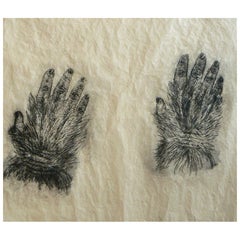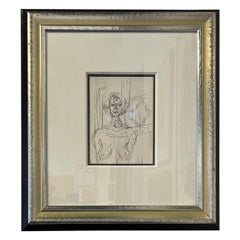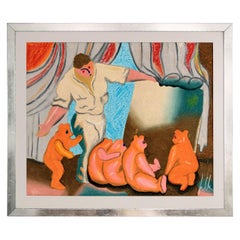Kiki Smith
American, b. 1954
Born in Germany in 1954, the daughter of minimalist sculptor Tony Smith, Kiki Smith was raised in the United States and has earned international status as one of the most significant artists of her time. She was chiefly influenced by Louise Bourgeois, Eva Hesse and Lee Bontecou. While she is best known for her often dissected, anatomical sculptures, she has also produced a body of innovative printed art.
Some of the major themes that Smith explores in her printed works include physiology, self-portraiture, nature, and female iconography. While her work in both mediums share a common psychological quality, she advances beyond the strict biological emphasis in her sculpture by including images such as snowflakes and butterflies in her prints.
Smith’s work has been featured at five Venice Biennales and she has had several major solo museum shows.Smith’s work is in several major museum collections, including the Museum of Modern Art, New York; Whitney Museum of American Art, New York; the Walker Art Center, Minneapolis; Solomon R. Guggenheim Museum, New York; The Metropolitan Museum of Art, New York; and the Museum of Contemporary Art, Los Angeles. She is a member of the American Academy of Arts and Letters and the American Academy of Arts and Sciences. In 2017, she was made an Honorary Royal Academician by the Royal Academy of Arts, London. In 2000 she was awarded the Skowhegan Medal for Sculpture and in 2009 the Edward MacDowell Medal. She also received the 2010 Nelson A. Rockefeller Award, Purchase College School of the Arts; the 2013 U.S. Department of State Medal of Arts, conferred by Hillary Clinton; and the 2016 Lifetime Achievement Award from the International Sculpture Center, to name just a few. Smith is an adjunct professor at NYU and Columbia University and lives and works in New York.to
1
1
1
1
1
1
1
1
1
23
10,707
3,927
2,503
2,241
Creator: Kiki Smith
Kiki Smith Etching
By Kiki Smith
Located in Long Island City, NY
“Prints mimic what we are as humans. We are all the same and yet everyone is different. I also think there’s a spiritual power in repetition, a devotional quality, like saying rosari...
Category
Late 20th Century American Kiki Smith
$8,750
Related Items
Alberto Giacometti Framed Black and White Limited Lithograph "Annette", 1964
By Alberto Giacometti
Located in Studio City, CA
A wonderful sketched lithograph by famed Swiss artists/sculptor Alberto Giacometti.
The lithograph was printed in Paris by Mourlot Freres in 1964 and was issued in an edition of ...
Category
1960s French Mid-Century Modern Vintage Kiki Smith
Materials
Paper
$1,245
H 25.5 in W 23 in D 1.5 in
Sandro Chia "Painter with Teddy Bears" Carborundum Etching 1989-90, Signed
By Sandro Chia
Located in New York, NY
Post Modern master Sandro Chia carborundum etching or mezzo-print titled "Painter with Teddy bears" is signed and numbered 8 of 50. Produced between 1989-90 in New York City. The pri...
Category
1980s American Post-Modern Vintage Kiki Smith
Materials
Paper
$3,375 Sale Price
55% Off
H 38 in W 43.25 in D 2 in
Leonor Fini Signed Framed Beautiful Lithograph Print Deux Femmes, circa 1970s
By Leonor Fini
Located in Studio City, CA
A beautiful lithographic print by Argentinian-born Italian surrealist painter, designer, illustrator, and author Leonor Fini titled "Deux Femmes".
Leonor Fini was arguably the most ferociously and heroically independent woman artist of the 20th century. Fini herself never accepted the label of "woman artist," and likewise, never considered herself a Surrealist despite her works having been included in nearly every major Surrealism exhibition from 1936 to the present. In the 1930s she lived in Paris, France where she collaborated with, or who were influenced by such prominent 20th-century artists as Jean Cocteau, Man Ray, Leonora Carrington, Salvador Dalí, Joseph Cornell, Dora Maar, Anna Magnani, Albert Camus, Jean Genet...
Category
1970s European Mid-Century Modern Vintage Kiki Smith
Materials
Paper
$1,495
H 20.15 in W 16.5 in D 1 in
FORNASETTI "Jerusalem by Night" Panel
By Piero Fornasetti, Fornasetti
Located in Los Angeles, CA
Rare original vintage "Jerusalem by Night" screen print on wood panel, designed by Piero Fornasetti / made in Milan Italy by Fornasetti
Original label on the back
Measures: width 37 ...
Category
Mid-20th Century Italian Mid-Century Modern Kiki Smith
Materials
Wood
Pablo Picasso Signed Limited Edition Etching Jeux de Gladiateurs Series 347:168
By Pablo Picasso
Located in Studio City, CA
An engaging work titled "Jeux de Gladiateurs" by famed Spanish artist Pablo Picasso.
The etching was created in 1968. It is hand signed in pencil by Picasso and numbered 33/50, lowe...
Category
1960s French Mid-Century Modern Vintage Kiki Smith
Materials
Paper
$10,000
H 11 in W 13.5 in D 0.1 in
Cecily Brown All the Nightmares Came Today Limited Edition Print
By Phaidon
Located in New York, NY
Print: Full color digital archival print on Epson Hot Press Natural 330g/m2
Size: 508 x 610 mm (20 x 24 in)
Edition of 100
This work will come with a signed and numbered archival ...
Category
2010s American Kiki Smith
Materials
Paper
$1,500 / item
H 24 in W 20 in D 0.1 in
Hans Fischer "Beasties" Etchings
By Hans Fischer
Located in Atlanta, GA
Hans Fischer "Beasties" etchings, circa 1959. These etchings are from the limited edition folio ''Homme Deguise en Homme" and dep...
Category
1950s French Mid-Century Modern Vintage Kiki Smith
Materials
Glass, Wood, Paper
Robert Motherwell Signed Limited Edition Large Aquatint Etching Blackened Sun
By Robert Motherwell
Located in Studio City, CA
A breathtaking, large in scope and scale, rivetting work by American abstract expressionist painter, and master printmaker Robert Motherwell (1915-1991).
This aquatint/lift ground ...
Category
1980s American Modern Vintage Kiki Smith
Materials
Paper
$19,500
H 48.5 in W 38.5 in D 0.75 in
Leonor Fini Signed Framed Lithograh Print Femme Avec Cheveux Rouge, circa 1970s
By Leonor Fini
Located in Studio City, CA
A beautiful lithographic print by Argentinian-born Italian surrealist painter, designer, illustrator, and author Leonor Fini titled "Femme Avec Cheveux Rouge".
Leonor Fini was arguably the most ferociously and heroically independent woman artist of the 20th century. Fini herself never accepted the label of "woman artist," and likewise, never considered herself a Surrealist despite her works having been included in nearly every major Surrealism exhibition from 1936 to the present. In the 1930s she lived in Paris, France where she collaborated with, or who were influenced by such prominent 20th-century artists as Jean Cocteau, Man Ray, Leonora Carrington, Salvador Dalí, Joseph Cornell, Dora Maar, Anna Magnani, Albert Camus, Jean Genet...
Category
1970s European Mid-Century Modern Vintage Kiki Smith
Materials
Paper
$1,495
H 21 in W 15 in D 1 in
Paul Gauguin Deux Femmes Maories Accroupies Limited Edition Lithograph Print
By Paul Gauguin
Located in Studio City, CA
A beautiful limited edition lithograph (Zincograph) by renowned French artist Paul Gauguin (1848-1903).
The work is titled "Deux Femmes Maories Accroupies" and was printed on smooth, cream imitation Japan paper around 1894-95. It is from an edition of approximately 200 from L'Epreuve--Album d'Art, Paris. Catalogue Raisonne
Kornfeld 26; Guérin 87.
The work has been professionally matted and framed and comes from the prestigious Kelton Collection in Los Angeles.
This exact piece can be found in The Museum of Fine Arts (MFA) in Boston.
A very good impression of this scarce print. Would be a great addition to any Gaugin or French Post-Impressionist art collection or eye-catching stand-alone accent work in about any setting.
Frame dimensions: 19.5" high, 23" wide, and 1.5" deep
Viewable...
Category
1890s French Antique Kiki Smith
Materials
Wood, Paper
$4,500
H 19.5 in W 23 in D 1.5 in
Masami Teraoka Signed Limited Ed 18 Color Lithograph Print Namiyo at Hanauma Bay
By Masami Teraoka
Located in Studio City, CA
A large and wonderfully detailed lithograph print by Asian/ Japanese American artist Masami Teraoka titled "Namiyo at Hanauma Bay". Teraoka conceived of this image in the 1980s while working on his New Wave series and Hawaii Snorkel series which featured snorkeling pearl divers, based on Utamaro's "Pearl Diver." In this image, the nude geisha...
Category
1980s American Modern Vintage Kiki Smith
Materials
Wood, Paper
$9,500
H 28.75 in W 39.75 in D 1.5 in
Signed Limited Edition Modern Abstract Japanese Woodblock Print Sunset Sailing
Located in Studio City, CA
A beautifully composed, richly and brightly coloured modern abstract Japanese style woodblock print titled "Sunset Sailing"
The work is han...
Category
20th Century Modern Kiki Smith
Materials
Metal
$295
H 11.25 in W 14.25 in D 1 in
Kiki Smith furniture for sale on 1stDibs.
Kiki Smith furniture are available for sale on 1stDibs.
Creators Similar to Kiki Smith
Questions About Kiki Smith
- 1stDibs ExpertApril 5, 2022Kiki Smith is a contemporary artist whose career has included sculpture, drawing, painting and other media to address issues such as mortality, gender and nature. Her multidisciplinary work is sought after by collectors worldwide. On 1stDibs, shop expertly-vetted Kiki Smith pieces from some of the world’s top art dealers.


